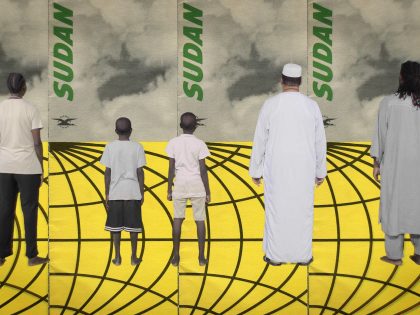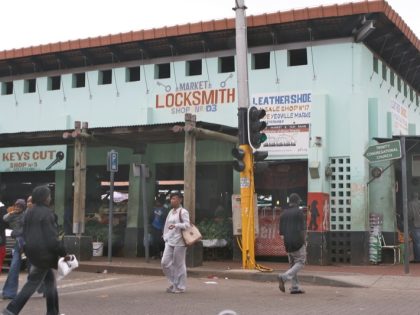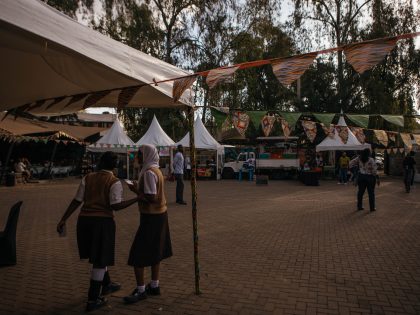Let them occupy
Housing struggles Brazil are a good case study to help us understand the limits of what is possible for urban housing movements in South Africa.

Photo: Dany13, via Flickr CC.
In 1991, South Africa’s African National Congress (ANC) convened a housing policy conference in Johannesburg. The organization had only been unbanned by the apartheid government the year before. Alongside negotiations for democratic elections and a new constitution, the ANC and its allies were deep in the throes of policy deliberations to prepare to take power. Thozamile Botha, a previously exiled trade unionist, was the convener of the party’s department of local and regional government planning. He delivered a stem-winder of a speech.
“In many former colonial countries, the post-independence trends are that only the Black elite is able to move to the city center or former white only areas,” he warned. “The people who have been in the forefront of the liberation struggle are easily forgotten. It is essential that the state should ensure that the benefits of freedom are enjoyed by all its citizens.”
The “internal” struggle against Apartheid — made up a wide range of associations and movements within the country while the ANC was in exile — was a big tent. It included the Congress of South African Trade Unions (COSATU), which grew into the largest union federation on the continent, and the United Democratic Front (UDF), the latter comprised of neighborhood associations, urban social movements, and cultural and religious organizations. Housing, basic services, and public transportation were common complaints.
Almost three decades later, the ANC-led government has built approximately 3 million houses. But the geographies of South Africa’s cities are as divided as ever. In Johannesburg, the country’s economic and, arguably, political heartland, racial segregation has diminished slightly, while class segregation is as persistent as ever, according to one analysis of census data. Related work in Cape Town, has found a similar trajectory in the nature of residential segregation since the end of Apartheid. Furthermore, the percent of the national households in informal settlements has barely budged, declining from 13.6% in 2002 to 13.1% in 2014. Despite the quantitative gains in housing delivery, many may rightly ask if Botha’s warning from 1991 has become reality.
Over the past 15 years, regular demonstrations in peripheral, poor neighborhoods in South Africa’s large cities has led many to dub the country “the protest capital of the world.” Yet these protests retain a distinctly atomized character, rarely moving beyond a single neighborhood. South Africa’s democratic era has witnessed primarily two types of housing movements. Some have carved out limited space to access funds for community-led, self-build projects in formal housing programs, and informal settlement upgrading programs for community-led approaches that minimize displacement from new development. A second set of movements have been more overtly militant, focusing on fights against evictions. However, it is rare to see housing movements move the policy agenda and priorities in South Africa’s major cities.
In order to understand why this is the case, one approach is to look elsewhere for comparative insights. Brazil is a good context to help us to understand the limits of the possible in South Africa. Brazil’s process of democratization in the mid-to-late 1980s, was fueled by a similar alliance of trade unions, housing movements, religious and cultural groups, intellectuals, and a political party of the left, the Workers’ Party (known by its Portuguese initials, PT).
In 1989, the PT swept to power in a number of key municipalities, though, unlike the ANC in South Africa, it would take until 2002 for the PT to first take national power. The PT had begun experimenting with municipal power beginning in 1982, when it began taking power in small municipalities outside São Paulo, the country’s largest city. However, it was only in 1989, a year after the passage of a new Federal Constitution, that the metropolis, now home to 12 million people, would be first run by the PT.
São Paulo’s first PT mayor, Luiza Erundina, had a long history working with housing movements and neighborhood associations as a social worker in the eastern zone of the city. The Erundina administration included key bureaucratic officials that had experience working with housing movements to fight evictions and to design and plan self-build housing projects. Though municipal finances were constrained in a period of national economic crisis, the Erundina administration was able to funnel significant resources to movements for self-build initiatives. This established a strong tie between the PT and a first generation of housing movements in the city’s new democratic era.
In the late 1990s, after at least a decade of disinvestment in São Paulo’s city center, a new generation of housing movements emerged with a much stronger focus on occupying abandoned downtown buildings. This younger generation had roots in the older movements that grew in the city’s periphery.
When a second PT mayoral administration took power in 2000 under Marta Suplicy, it was unsurprising to see the administration introduce a new social housing policy focused on the city center. New planning instruments introduced in the city’s master plan also made it possible for the city to declare areas of the city “special zones of social interest” to enable this policy. Such planning instruments helped achieve significant material gains for city residents. Access to basic sanitation for households in informal settlements has almost tripled in São Paulo since democratization. In Johannesburg, it has grown by only 30%.
As the PT gained national strength, and two generations of housing and workers’ movements gained institutional legitimation and acceptance, a breakaway from the more rural-focused Landless People’s Movement (MST) began occupying large tracts of land in the outskirts of São Paulo, mostly in neighboring municipalities. The MST was one of the key movements in the “social movement unionist” alliance that animated Brazil’s democratic transition and eventually brought the PT to national power. It had focused for decades on the struggle to redistribute the large landholdings of traditional elites to smallholder farmers and co-operatives. The MST’s urban breakaway, the Homeless Workers’ Movement (MTST), introduced a new radical element to housing politics in São Paulo and, increasingly in many other cities across the country. The MTST declined to participate in institutionalized spaces for public participation, and generally opted for a more confrontational style of movement politics. This may have helped it maintain a mass base as the PT became increasingly enmeshed in the traditions and alliances of the political establishment the longer it was in power.
Even as the MTST grew, older movements maintained a solid core of support. These older movements mixed strategies of participation in institutional spaces to influence policy, using subsidies for community-led housing projects under the national housing program introduced by the PT in 2009, and continued occupations. These movements, often linked to the Front for the Housing Struggle (FLM) and the Federation of Housing Movements (UMM), continued to occupy land in peripheries and abandoned buildings in disinvested, now gentrifying inner cities across the country.
Once right-wing parties in Congress began to initiate impeachment proceedings against PT president Dilma Rousseff in 2015, with dubious justification, these movements were central protagonists in the creation of two allied fronts to defend Dilma. The MTST formed the People Without Fear (PSM), and the UMM and FLM were part of the Popular Brazilian Front (FBP). While the FBP was more closely aligned with the PT, both participated and organized numerous joint protests during and after the process to impeach Dilma. These efforts were too sporadic to provide an effective popular bulwark against the traditional political elite’s “parliamentary coup” against the elected PT national executive. Furthermore, they came amidst a general public disaffection with the entire political class due to spiraling corruption investigations that have implicated leading politicians in all parties, including current president Michel Temer, whose approval rating hovers in single digits.
Brazil is currently roiled by politicized corruption investigations. Traditional elites seem unable to find a political standard-bearer to represent their interests effectively in upcoming elections in October. The PT is now the only programmatic party on the left or right that remains in mainstream politics.
Late last month, an appeals court in the southeastern city of Porto Alegre upheld a conviction of former president Luiz Inácio “Lula” da Silva of the PT. The three-judge panel acknowledged that it had no direct proof that he had ever had possession of the apartment he is accused of receiving as a bribe. Conviction was based almost exclusively on plea bargain testimony of a disgraced corporate executive imprisoned for bribing a number of politicians. Massive protests organized by unions and housing movements in Porto Alegre and São Paulo greeted Lula as he moved between the two cities after the ruling.
The evening after the ruling, Lula appeared at a rally in Praça República in central São Paulo, alongside MTST leader Guilherme Boulos. “If it’s mine, then even Boulos could send someone to occupy this apartment. Let them occupy!” he joked, referring to the apartment he is alleged to have received as a bribe. While the recent politicization of the judiciary threatens to undermine Brazilian democracy, the defense of the inclusionary gains of the PT years and the deepening of democratic institutions will fall to mass mobilization by housing movements.
Contrast this to the absence of housing movements as protagonists in South Africa’s ongoing democratic crisis. No national housing movement in the post-Apartheid era has found a way to have independent, lasting influence in the formal political arena. The absorption of non-union antiapartheid movements into the South African National Civics Organization (SANCO), entailed, to a significant degree, a capitulation to the directives of the ANC at the level of national politics. COSATU, SANCO, and the South African Communist Party comprised the most significant base of Zuma’s rise to power in the mid-2000s. But none of these organizations raised serious protest as Zuma mounted a patronage network across key institutions of the state, and some leaders were absorbed into this network. By the time a serious challenge to Zuma emerged within the ANC in the form of former trade unionist and more recent business tycoon Cyril Ramaphosa, COSATU was a shadow of its former self, having split in two, and not a word was heard from urban housing movements.
In December in Johannesburg, a day after Ramaphosa was elected the new leader of the ANC, Enoch Godongwana, the party’s head of policy (a former unionist himself), stood on a podium and delivered the much-contested resolutions of the ANC’s policy committee on land. For South Africa’s urban majority, the silence was deafening.
For years, commentators and political activists have expended significant energy on the proposal of “expropriation without compensation”. This was an animating idea behind the “radical economic transformation” platform of Nkosazana Dlamini-Zuma’s bid for party president. For years, Dikgang Moseneke, now the former Deputy Chief Justice of the Constitutional Court, has noted that no state institution has been willing to bring a case to court to test the relevant constitutional provisions for land expropriation.
In December 2017, Godongwana announced that the ANC would now pursue precisely such an agenda on land. This announcement underscored at least two ironies. First, it remains unclear what actually needs to be amended in a constitution that already provides for expropriation without compensation in cases of historical redress. Second, the resolution has nothing to say about the administration of urban land. A rigid land tenure regime in cities has slowed upgrading of informal settlements and made it difficult for poor people in cities to access a formally recognized home.
Ultimately, the prospect of realizing rights in the city remains a political question that cannot be solved through legal means alone. That the policy debate on land is so far removed from some of the most pressing needs for the future of South Africa’s working class and entire economy suggests that something has gone wrong in the social politics of its cities. Post-Apartheid South Africa has witnessed a growing gulf between urban housing movements and the formal political sphere.
The link between urban housing activism and challenges to still new democratic institutions has become clear in recent years in both South Africa and Brazil. In South Africa, a fightback against “state capture” under Zuma has been led by a class of professional elites, including dedicated civil servants, some business leaders, and intellectuals. Ramaphosa’s recent victory for the post of ANC party president represents the early fruits of this still ongoing struggle. But the absence of grassroots actors suggests that the programmatic basis of party and state reform will not necessarily be responsive to South Africa’s social majority, especially in its cities.
In Brazil, urban housing movements have been able to use the formal political sphere, especially through power realized at the municipal level, to build a dynamic ecosystem of housing-based activism. This has been relatively sustained despite similarities between the PT and the ANC in tending towards what German political scientist Robert Michels described over a century ago as “the iron law of oligarchy.”
On 31 October of last year, the MTST mobilized an estimated 25,000 activists occupying land across the São Paulo region to march 27 kilometers to the palace of the state governor to demand the release of land for housing. And on the day Brazilians learned of Lula’s failed appeal of his conviction, the banners of MTST joined with older generations of still vibrant housing movements in defense of democracy in Brazil. The mobilization of these activists may yet bring Brazil back from the democratic abyss that otherwise faces the country if Lula is unable to run for president in October this year. The defense of democratic institutions in South Africa remains without an organized urban working class protagonist.



















